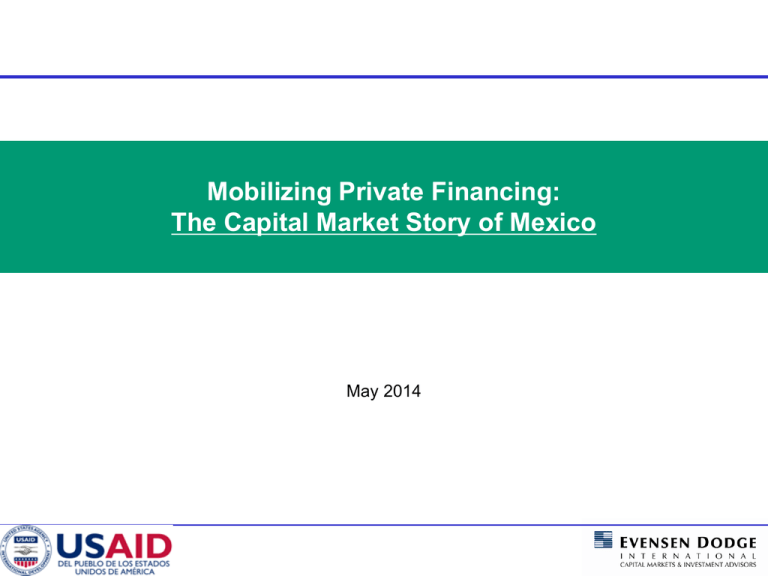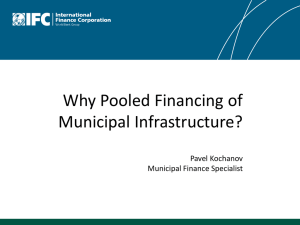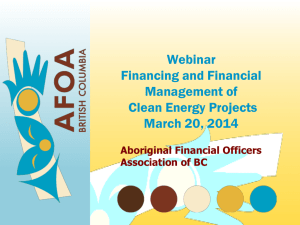Fernando Gama Presentation - Woodrow Wilson International
advertisement

Mobilizing Private Financing: The Capital Market Story of Mexico May 2014 Content Mobilizing Private Financing: The Capital Market Story of Mexico a) The fundamental changes in infrastructure financing introduced in the Mexican context: 2000 – 2013 b) The financial model for pooled financing through bond banks in Mexico c) The impact of pooled financing for Mexican urban infrastructure i) Micro level: Example transactions. ii) Macro level: Changes in the volume of long term domestic financing for infrastructure since 2000 Background • In March 2002, USAID/Mexico and Evensen Dodge International Inc. (EDII), a global public finance advisory firm, entered into cooperative agreement and in 2005 into Global Development Alliance partnership. Evensen Dodge is a historic firm Evensen Dodge founded in 1922, was the first independent financial advisory firm in the US. Participated in developing the US subnational (municipal) bond market. Has assisted over 1000 subnational organizations access financing over $200 billion. Is working internationally with USAID as Evensen Dodge International. In Mexico mobilized $2 billion with USAID GDA Program Global Development Alliance Objective • Through a Global Development Alliance, USAID and Evensen Dodge International are pursuing sustainable financing strategies, specifically to mobilize private sector financing for infrastructure development with creditworthy public entities. • The objective of the Alliance between Evensen Dodge International Inc. (EDII) and the USAID Mission to Mexico (USAID/Mexico) is to increase Mexican private investment in essential infrastructure by helping a wider range of public entities improve their access to financing from Mexican’s capital market. • The Alliance between EDII and USAID is directly focused on the objective of mobilizing large amounts of capital from Mexico’s financial community for the effective implementation of infrastructure projects funded with the instruments developed under this program. Innovative Financing for Urban Infrastructure • The Alliance approach leverages public sector resources to mobilizing private investment in urban infrastructure. • The Alliance is attracting Mexican institutional investors to urban infrastructure. • The Alliance is developing long-term debt financing and PPP structures where each is most appropriate. • The Alliance adapts proven world class financing models, legal and institutional frameworks for use in Mexico. The fundamental changes in infrastructure financing introduced in the Mexican context: 2000 – 2013 (Graphic Overview) - Linking Entities to the Market Mobilizing Capital Linking Entities to Funding FINANCIAL MARKETS ENTITIES PUBLIC ENTITIES NATIONAL EDI-USAID Alliance BANKS MULTILATERAL PROVINCIAL / STATES DEVELOPMENT LOCAL COMMERCIAL PUBLIC-PRIVATE CORPORATIONS UTILITIES BOT, PPP, BOO PRIVATE – NON GOV’T ORGANIZATIONS PROVIDING PUBLIC SERVICE SMALL-MEDIUM SIZE FIRMS INSTITUTIONAL INVESTORS LINKS PARTIES TOGETHER PENSION FUNDS INSURANCE CO.’s MUTUAL FUNDS CORPORATE INVESTORS PRIVATE CAPITAL FUNDS FINANCIAL MARKETS OVERVIEW EVENSEN DODGE COORDINATES FINANCIAL PROGRAM INVESTORS PUBLIC ENTITY REQUEST FUNDING DEBT OR EQUITY ISSUANCE PENSION FUNDS INSURANCE COMPANIES REVENUE FLOWS LEGAL FRAMEWORK CREDIT ENHANCEMENT OTHER INVESTORS PRIVATE CAP FUNDS PPP or SPV PARAMETERS BANK LOAN TRUST RATING AGENCIES FINANCING BANKS FINANCIAL MARKETS OVERVIEW CASE STUDY: MEXICO YEAR 2000 FINANCIAL ADVISOR INVESTORS PUBLIC REQUEST FINANCING ENTITY DEBT ISSUANCE PENSION FUNDS BANK LOAN REVENUE FLOWS LOCAL TAXES CREDIT ENHANCEMENT LEGAL FRAMEWORK FINANCIAL VEHICLE TAXES TRUSTS RATING AGENCIES LONG TERM FINANCING INSURANCE COMPANIES OTHER INVESTORS PRIVATE CAP FUNDS TAX INCENTIVES BANKS FINANCING FINANCIAL MARKETS OVERVIEW CASE STUDY: MEXICO YEAR 2002 FINANCIAL ADVISOR INVESTORS PUBLIC ENTITY GOV’T UNIT OR PPP REQUEST FINANCING DEBT ISSUANCE PENSION FUNDS BANK LOAN REVENUE FLOWS LOCAL TAXES CREDIT ENHANCEMENT LEGAL FRAMEWORK FINANCIAL VEHICLE PLAN TAXES TRUSTS RATING AGENCIES LONG TERM FINANCIAL FINANCING LONG TERM INSURANCE COMPANIES OTHER CORPORATE INVESTORS PRIVATE CAP INDIVIDUAL FUNDS INVESTORS TAX INCENTIVES BANKS FINANCING The impact of introducing pooled financing for Mexican urban infrastructure A) The Bond Bank financial model B) Micro level impact: Example transactions C) Macro level impact: Changes in the volume of long term domestic financing for infrastructure since 2000 Changing the Financing paradigm for Urban Infrastructure in Mexico Changed the standard mechanism for the conduct of public finance in Mexico. The Alliance has assisted in introducing an innovative master trust structure for use by Mexican local government entities. This trust has become the finance industry standard in Mexico since it was implemented in 2002. Built efficient SPVs to foster mobilization of capital for development. The Alliance introduced innovative pooled-financing structures to Mexico with strong positive reaction from rating agencies and private lenders, as demonstrated by high credit ratings and record-low total interest cost and borrowing costs. The SPVs linked over 170 local government entities to the domestic capital markets. This solution has also become the finance industry standard in Mexico for pooled-financing transactions for local government entities in Mexico. On-going innovation. The Alliance is continuing to apply its innovative model to develop mechanisms to attract private investment and to finance projects that will generate new jobs, improve the environment, and strengthen social services in to Mexican border cities and states to support economic growth and development of strong and resilient communities. BOND BANK MODEL Mexican Subnational Bond Bank Bond Bank • Governance: Public or Private Mexican Corporation • Provides Advice and Financing State Government Local Gov’t Other Entities Public Corp Bond Bank provides PPPs The Pooled Financing Model • Pooled financing combines the financing needs of several (or even many) public entities, such as municipalities or utilities, into a single financing transaction to achieve the best possible terms for all participating entities. • Evensen Dodge pioneered this form of financing in the U.S. through the development of bond banks in several states. • The entities that access financing through a bond bank are usually relatively small and have financing requirements that are too small to attract the local capital market on their own. • By participating in a bond bank pooled financing transaction, such entities gain the following benefits: They will not necessarily require credit ratings They will not require collateral from the national government They will have access to financing at a lower cost and for a longer term They will receive legal and financial advice from the bond bank They will achieve economies of scale from the pooled financing process BOND BANK MODEL PROCEDURE FOR OBTAINING AUTHORIZATION PUBLIC ENTITIES Process Application to participate in next transaction BOND BANK Financial Markets State Congress Invites entities to participate in transaction Application Reviewed With EDI, Provides technical assistance to cities to develop required legal and financial documentation obtains authorizations from Governing Body Packages up individual or pooled financing documentation Congress Authorizes BOND BANK MODEL PROCEDURE FOR OBTAINING FINANCING PUBLIC ENTITIY BOND BANK Given the authorization from Congress Negotiates with service providers to reduce costs of financing Each Entity establishes financing agreement with Bond Bank Each Entity receives financing from the Bond Bank Bond Bank enabled to irrevocably receive revenue streams from Entities to pay for financing Receives Financing to Develop infrastructure Financial Markets Service Providers Bond bank accesses financing from investors and financial institutions FINANCING BECOMES AVAILABLE PAYS FEES TO SERVICE PROVIDERS BOND BANK MODEL PROCEDURE FOR REPAYING DEBT OBLIGATIONS PUBLIC ENTITES BOND BANK TRUST Percentage of National tax Transfers, Local Taxes Or Fees $ % BOND BANK FINANCIAL MARKETS • Bookkeeping • Supervision & Assessment IRREVOCABLE TRUST Intercepts revenue streams Creates Reserve Accounts and pays for SPV operation IRREVOCABLE PAYING MECHANISM Pays for debt obligations Investors get their money promptly Pooled Financing Model Summary • A bond bank is a pooled financing vehicle structured to provide certainty and transparency to the entities and investors participating in the pooled financial operations it implements. • The financial vehicle could be a corporation, non-governmental organization, public organization or master trust fund. • Bond banks typically also provide advisory services to municipalities and local utilities participating in the pooled financing. • The bond bank establishes a Transactional Trust account to implement each pooled financing operation; it should implement at least one per year. The model averts credit risk for each transaction and provides the legal and procedural soundness that investors and/or creditors require to finance larger volumes of money at lower cost and longer terms. • Examples of Evensen Dodge services to a long term client follows: The State Bond Bank of the State of Hidalgo and the State Bond bank of Quintana Roo Micro Impact: The Hidalgo State Bond Bank and its pooled financing transactions The State Bond Bank of the State of Hidalgo • The Mexican State of Hidalgo selected Evensen Dodge International to develop the first bond bank to execute pooled financing in Mexico. The bond bank received a AAA.mx rating (the state’s stand-alone rating is A). The Bond Bank issued US$240 million equivalent in refinancing bonds on May 10th, 2007, which were over-subscribed and sold at a record rate of Mexican prime plus 14 basis points for a term of just over 12 years. The refinancing saved the state millions of dollars and has given it needed room for future borrowing for infrastructure. • In May 2010, the Bond Bank borrowed US$40 million equivalent on behalf of 60 of the state’s 84 municipalities; this enabled these entities to access long-term financing at competitive market rates at a fixed rate of 7.2% (record low for transactions involving municipalities). This transaction is unique because it served very small and poor municipalities some of which had never gotten a loan before in history. Micro Impact: The Hidalgo State Bond Bank and its pooled financing transactions The State Bond Bank of the State of Hidalgo (continues) • In March 2012, the Bond Bank borrowed approximately US$200 million equivalent on behalf of the State Government and 20 of the state’s 84 municipalities; the transaction included a state refinancing for land purchased for a new oil refinery (to be built by the federal government), and new money for a state administrative complex. In addition, this transaction included roughly 20 underlying municipalities borrowing to make green improvements to their public lighting systems. The transaction closed at Mexican prime plus 95 basis points for a term of 15 years. The transaction saved the state millions of dollars and empowered the municipalities with a record-low cost financing for municipal infrastructure. Micro Impact: Quintana Roo Pooled Financing for Water and Sewer Infrastructure State of Quintana Roo Water and Sewer Pooled Financing • In October 2007, the state water and sewer utilities corporation (CAPA) accessed financing through a pooled financing transaction structured by Evensen Dodge International. • One of the state’s priorities was to provide maintenance and to expand its water and sewer infrastructure to satisfy the growing demands of the population. CAPA, a public-private corporation, pooled the financing requirements of several small municipalities to access domestic currency in an amount equivalent to $30 million dollars. • The Federal Government matched this with another $30 million. Financing was in the form of a bank loan from Citi-Bank. • The credit rating achieved was of AA.mx from FitchRatings and Moody’s. The interest rate benchmarked prime +19bps. For water and sewer infrastructure in Mexico the standard had been a spread of +500 to +800 bps if any financing was available at all. Term was 15 years with grace of 2 in principal payment. Micro Impact: Quintana Roo Pooled Financing for Water and Sewer Infrastructure State of Quintana Roo Water and Sewer Pooled Financing • The financing transaction that the Quintana Roo water utilities corporation (CAPA) undertook in October 2007 is a model for capital mobilization. • It swapped low credit rated revenue streams with high rated ones, achieving the best financing conditions possible in the debt markets. • No external partial credit guarantees were required. • New drinking water infrastructure benefited 77,012 inhabitants. • New sewer and sanitation infrastructure benefited 146,879 inhabitants. Tlaxcala Campeche Queretaro Baja California Sur Yucatan Colima Aguascalientes Guerrero Tabasco Hidalgo San Luis Potosi Morelos Tamaulipas Oaxaca Durango Zacatecas Nayarit Sinaloa Guanajuato Puebla Baja California Chiapas Michoacan Sonora Quintana Roo Chihuahua Jalisco Coahuila Mexico Veracruz Nuevo Leon Distrito Federal PUBLIC FINANCE STATISTICS STATE DEBT, AT DEC 2013 (MILLIONS OF PESOS) $70,000.00 $60,000.00 $50,000.00 $40,000.00 $30,000.00 $20,000.00 $10,000.00 $- Tlaxcala Campeche Colima Tabasco Queretaro Yucatan Tamaulipas Guerrero Oaxaca Hidalgo Puebla Guanajuato San Luis Potosi Mexico Sinaloa Aguascalientes Morelos Baja California Sur Durango Zacatecas Jalisco Baja California Michoacan Distrito Federal Nayarit Sonora Chiapas Veracruz Coahuila Nuevo Leon Quintana Roo Chihuahua Estadísticas de las finanzas públicas en los estados 800% STATE DEBT / TAX TRANSFRS, AT DEC 2013 (%) 700% 600% 500% 400% 300% 200% 100% 0% Estadísticas de las finanzas públicas en los estados STATE DEBT AVERAGE DEBT COST, AT DEC 2013 (INTEREST RATE) 7.50% 7.00% 6.50% 6.00% 5.50% 5.00% 4.50% Macro Impact of the EDII-USAID Alliance in Mexico The U.S. Agency for International Development (USAID) reported that Evensen Dodge International work has resulted in significant contributions to the field of local government finance in Mexico: Benefitted over 10 million citizens. The Alliance has directly benefited over 10 million Mexican citizens by improving their living conditions, some of which were below the poverty line level, with funding for schools, roads, energy efficient programs, prisons, interior ports to foster commerce and manufacturing production, health clinics, natural disaster reconstruction, housing, and water and sewer facilities among other major infrastructure programs in different states in the Mexico. Mobilized over $40 Billion. The local government implementing partners participating in the Alliance have mobilized over $2.0 Billion from Mexico’s domestic capital markets to finance their infrastructure projects while drastically reducing borrowing costs. Mexican states and municipalities have replicated the models developed by this Alliance to mobilize over $40 Billion dollars of well-structured sound financing, all in domestic currency, with Mexican financial institutions and investors. Trained and built the capacity of more than 1,000 public officials and private sector professionals Macro Impact of the EDII-USAID Alliance in Mexico Mobilizing domestic credit to build basic infrastructure projects that will benefit more people, especially urban poor, Lowering costs of issuance to encourage more sovereign and subnational entities to seek capital markets financing because of real savings opportunities, Providing country investors with more transparency elements to become increasingly comfortable with sector and sub-national financial operations and Conducting Capital Markets activities to encourage stronger financial reporting standards Thank You Mobilizing Private Financing: The Capital Market Story of Mexico Fernando Gama, Senior Vice President Evensen Dodge International EVENSENDODGE@DODGEGLOBAL.COM






